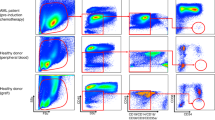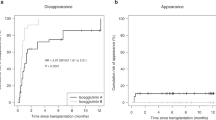Abstract
The aim of this study was to determine the complement functions, the serum levels of the complement components C3 and C4, and circulating immune complexes during autologous blood stem cell transplantation. Seventeen lymphoma patients receiving transplants between 1997 and 2001 were involved in this study. High-dose chemotherapy with or without total body irradiation was used for conditioning. The transplantation resulted in complete remission without complications in 14 patients. Early relapse developed in one case and two nonrelapsed patients suffered from serious toxic infection early posttransplant. Normal values of CH50, C3, C4, and immune complexes in sera of patients were detected on day −7, before the conditioning (day of transplantation was determined as day 0). After the conditioning, on day −2, the levels of the CH50, C3, and C4 decreased significantly (p<0.05) in all patients compared with the starting values. The CH50, C3, and C4 levels exceeded the starting values in the noninfected patients from day +7. In two patients suffering from toxic infection, significantly elevated complement levels were documented early posttransplant. In the relapsed patient a significant decrease of the complement parameters was documented posttransplant accompanied by a significant elevation in the immune complex level. The results show alteration in the complement parameters during transplantation, but in the complication-free cases this remained within the normal ranges. However, an unusual elevation seemed to be the sign of infection, and the significant decrease seemed to indicate a relapse.




Similar content being viewed by others
References
Ahmed AE, Peter JB (1995) Clinical utility of complement assessment. Clin Diagn Lab Immunol 2(5):509–517
Apperly J, Bacigaluppo A, Friedrich W, Girinsky T (2000) Principles of conditioning regimens. In: Apperly J, Gluckman E, Gratwohl A (eds) The EBMT handbook 2000, revised edition: blood and marrow transplantation. ESH, Paris, pp 93–107
Arpaci F, Dogru T, Ozturk B, Komurcu S, Ozet A, Yilmaz MI, Beyzadeoglu M, Turan M, Sengul A, Yalcin A (2002) Changes in immunological recovery in patients who received post-transplant G-CSF or GM-CSF after autologous peripheral blood stem cell transplantation (PBSCT). Haematologia 32(3):253–264
Banyai A, Paloczi K, Csipo I, Csongor I, Szegedi Gy (1990) Complement-mediated immune complex solubilization and precipitation inhibition in sera of patients with non-Hodgkin’s lymphoma. Haematologia 23(2):87–95
Bierman PJ, Armitage JO (1998) Lymphoma. In: Reiffers J, Goldman JM, Armitage JO (eds) Blood stem cell transplantation. Martin Dunitz, London, pp 101–127
Hazelzet JA, de Groot R, van Mierlo G, Joosten KFM, van der Voort E, Eerenberg A, Suur MH, Hop WCJ, Hack CE (1998) Complement activation in relation to capillary leakage in children with septic shock and purpura. Infect Immun 66(11):5350–5356
Johnson AJ, Mowbray JF, Porter KA (1975) Detection of circulating immune complexes in pathological human sera. Lancet 1:762–765
Kohler PF, Müller-Eberhard HJ (1967) Immunochemical quantitation of the third, fourth and fifth components of human complement: concentration in serum of healthy adult. J Immunol 99:1211–1216
Nilsson UR, Nilsson B (1984) Simplified assay of haemolytic activity of the classical and alternative complement pathway. J Immunol Methods 72:49–59
Paloczi K (2000) Immune reconstitution: an important component of a successful allogeneic transplantation. Immunol Letters 74:177–181
Platt JL, Saadi S (1999) The role of complement in transplantation. Mol Immunol 36(13–14):965–971
Salat C, Holler E, Schleuning M, Eisele B, Reinhardt B, Kolb H, Pihusch R, Domrath R, Hiller E (1995) Levels of the terminal complement complex, C3-desArg and C1-inhibitor in adult patients with capillary leak syndrome following bone marrow transplantation. Ann Haematol 71(16):271–277
Salles G, Coiffier B (1999) Autologous peripheral blood stem cell transplantation for non-Hodgkin’s lymphoma. In: Gorin N-C (ed) Bailliere’s clinical haematology. Harcourt, London, pp 151–169
Stöve S, Welte T, Wagner TO, Kola A, Klos A, Bautsch W, Köhl J (1996) Circulating complement component proteins in patients with sepsis or systemic inflammatory response syndrome. Clin Diagn Lab Immunol 3(2):175–183
Takatsuka H, Takemoto Y, Yamada S, Wada H, Tamura S, Fujumori Y, Okamoto T, Suehiro A, Kanamaru A, Kakishita E (2000) Complications after bone marrow transplantation are manifestations of systemic inflammatory response syndrome. Bone Marrow Transplant 26:419–426
Varga L, Poros A, Panya A, Kramer J, Gyodi E, Füst G (1995) Clinical significance of longitudinal complement measurements in recipient of bone marrow transplant. Bone Marrow Transplant 15:509–514
Witherspoon RP, Kopecky K, Storb RF, Flournoy N, Sullivan KM, Sosa R, Deeg HJ, Ochs HD, Cheever MA, Fefer A, Thomas ED (1982) Immunological recovery in 48 patients following syngeneic marrow transplantation for haematological malignancy. Transplantation 33:143–149
Yang YG, Chen AM, Sergio JJ, Zhou Y, Sykes M (2000) Role of antibody-independent complement activation in rejection of porcine bone marrow cells in mice. Transplantation 69(1):163–165
Author information
Authors and Affiliations
Corresponding author
Rights and permissions
About this article
Cite this article
Banyai, A., Varga, L., Barta, A. et al. Monitoring the level of complement components during autologous blood stem cell transplantation in patients with malignant lymphomas. Cancer Immunol Immunother 53, 835–839 (2004). https://doi.org/10.1007/s00262-004-0519-7
Received:
Accepted:
Published:
Issue Date:
DOI: https://doi.org/10.1007/s00262-004-0519-7




